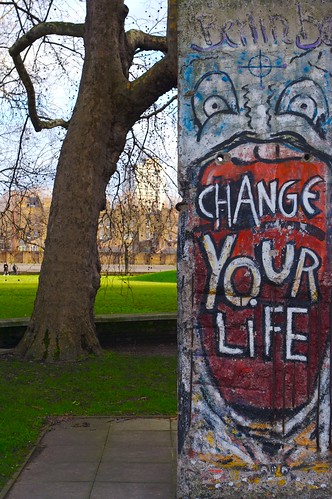Tuesday, January 23, 2007
The Gordon Riots of 1780 and Barnaby Rudge
Photo: A section of the Berlin Wall on the grounds of the Imperial War Museum. The march on Parliament began near here on open space known as St. George’s Fields on Friday 2nd June at ten o’ clock in the morning, 1780.
“A mob is usually a creature of very mysterious existence, particularly in a large city. Where it comes from or whither it goes, few men can tell. Assembling and dispersing with equal suddenness, it is as difficult to follow to its various sources as the sea itself; nor does the parallel stop here, for the ocean is not more fickle and uncertain, more terrible when roused, more unreasonable, or more cruel.– Charles Dickens Barnaby Rudge: A Tale of the Riots of ‘Eighty.
London, 1780: Under the leadership of Prime Minister Lord North Great Britain was fighting a difficult war in her American colonies. American diplomats working in France had brought England’s old enemy into the battle. Britain was in desperate need of more troops, and one attempt to get them had been a government bill, the Catholic Relief Act of 1778 that was designed to lessen the obstacles to Catholics serving in the military. The Act inspired fierce resistance amongst Protestants in both England and Scotland. In 1779 violent protests against a similar act being introduced in Scotland had broken out in Glasgow and Edinburgh.
On June 2nd of 1780 60,000 members of the Protestant Association, led by Lord George Gordon, massed in London to present a petition to Parliament calling for the repeal of the act. It’s members wore blue ribbons in their hats as a sign of unity. Despite physical intimidation of the legislators, a vote on the petition that afternoon was overwhelmingly defeated.
That evening Catholic chapels belonging to foreign embassies were destroyed by a mob chanting “no popery”. Although the initial violence may have been political, or sectarian, and anti-Catholic violence occurred throughout the course of disturbance, the riots as they evolved over the next week became a savage and tumultuous expression of rebellion by London’s poorest. Violence was directed at the authorities and anybody who opposed the mob, and looting was rampant. For while it looked like the government would be unable to retain control of the city. Contemporaries found this taste of revolution profoundly shocking: “the English reaction to the French revolution began well before it’s out break.”
Mapped here







